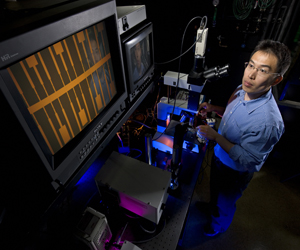Dr. Xinjian Zhou
The EurekAlert! article Sandia researchers construct carbon nanotube device that can detect colors of the rainbow said
Researchers at Sandia National Laboratories have created the first carbon nanotube device that can detect the entire visible spectrum of light, a feat that could soon allow scientists to probe single molecule transformations, study how those molecules respond to light, observe how the molecules change shapes, and understand other fundamental interactions between molecules and nanotubes.
“In our eyes the neuron is in front of the retinal molecule, so the light has to transmit through the neuron to hit the molecule,” says Sandia researcher Xinjian Zhou. “We placed the nanotube transistor behind the molecule — a more efficient design.
Zhou and his Sandia colleagues François Léonard, Andy Vance, Karen Krafcik, Tom Zifer, and Bryan Wong created the device. The team recently published a paper, “Color Detection Using Chromophore-Nanotube Hybrid Devices,” in the journal Nano Letters.
The idea of carbon nanotubes being light sensitive has been around for a long time, but earlier efforts using an individual nanotube were only able to detect light in narrow wavelength ranges at laser intensities. The Sandia team found that their nanodetector was orders of magnitude more sensitive, down to about 40 W/m2 — about 3 percent of the density of sunshine reaching the ground. “Because the dye is so close to the nanotube, a little change turns into a big signal on the device,” says Zhou.
Xinjian Zhou, Ph.D. is Postdoctoral Fellow at Sandia National
Laboratories where he specializes in research and fundraising in the
fields of Nanoscience and Nanotechnology, Physics, and Material Science.
Xinjian authored
Carbon Nanotube Transistors, Sensors, and Beyond: An Introduction to
Carbon Nanotubes, a Study of Their Electrical Properties and an
Exploration of Their Applications in Nanobiotechnology, and
coauthored
Band Structure, Phonon Scattering, and the Performance Limit
of Single-Walled Carbon Nanotube Transistors,
Supported Lipid Bilayer/Carbon
Nanotube Hybrids,
Probing Electrostatic Potentials in
Solution with Carbon Nanotube
Transistors,
Color Detection Using Chromophore-Nanotube
Hybrid Devices,
High temperature electrical resistance of substrate-supported single
walled carbon nanotubes, and
Carbon Nanotube FET Mixers and High Frequency Applications.
He earned his B.S. in Physics at Peking University in 2001 and his
Ph.D. in Physics at Cornell University in 2007 with the dissertation
Carbon nanotube transistors, sensors, and beyond.
Visit his
facebook page.





